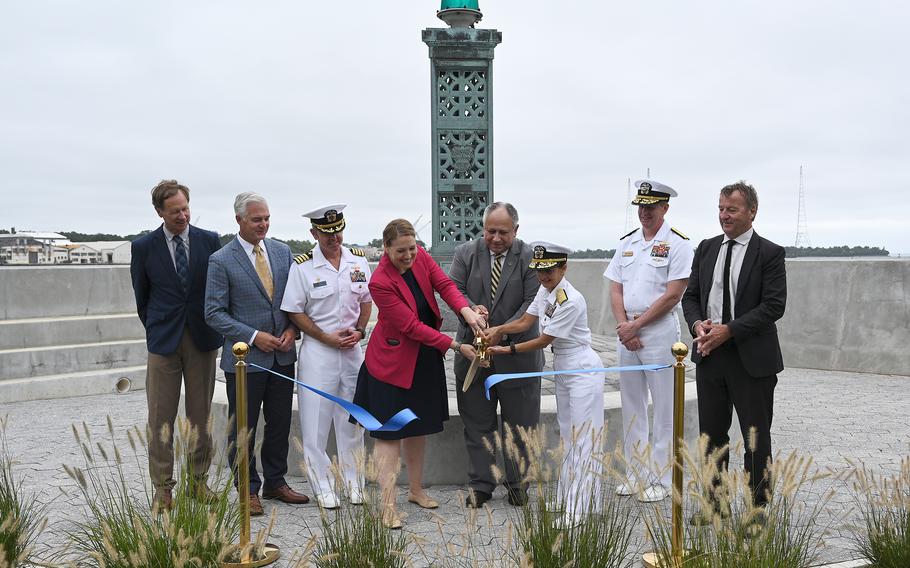
Assistant Secretary of the Navy Meredith Berger, Secretary of the Navy Carlos Del Toro and Naval Academy Superintendent Vice Adm. Yvette M. Davids cut the ribbon. The Naval Academy celebrated the completion of the Farragut Sea Wall with a ribbon cutting ceremony Friday morning. (Paul W. Gillespie/Capital Gazette)
(Tribune News Service) — The new Farragut Sea Wall at the Naval Academy is finally complete.
Less than two years after officials broke ground on the project, the sea wall, which extends from Santee Basin and the Robert Crown Sailing Center past Triton Light, has been repaired and reinforced, capping off the first of many efforts to bolster the academy’s resilience against future rising sea levels. Federal, county and city officials marked the conclusion of the project Friday morning with a ceremonial ribbon cutting.
The record number of flooding events on the Yard this year alone poses an “existential threat” to the waterfront grounds, said Naval Academy Superintendent Vice Adm. Yvette Davids.
“Although the danger to the continued existence of our academy is clear, we will not stand still as we watch the sea rise around us because our Navy and Marine Corps, our Naval Academy, adapts to whatever [dangers] we face,” she said.
The work at the academy included repairs to the sheet pile bulkheads along Farragut Field and the southeast side of Santee Basin, as well as construction of a new sheet pile bulkhead and a tieback system to reinforce the support system. Reconstruction and repaving of Brownson and Turner Joy roads and restoration of the Class of 1945 sea gate were also completed, the academy said in a news release.
Triton Light, the iconic navigational beacon situated on the seawall, was not in operation during construction. The light was reinstalled at its original location and raised to the new elevation for visibility above the new wall.
Officials broke ground on the project in November 2022, two months after the Naval Facilities Engineering Systems Command Washington awarded a $37.5 million contract to Cianbro Corporation for the repairs.
Concerns with the Naval Academy’s sea wall date back several years. A prior assessment of the condition of the academy’s facilities found the existing steel sheet piles in bulkheads at Farragut Field and the east wall of Santee Basin showing increased deterioration, with corrosion holes developing below the concrete pile caps.
Due to the sea wall’s location at the eastern corner of the academy grounds, where the Severn River meets Spa Creek and the Annapolis Harbor, it’s been subject to flooding from high tides and sustained winds blowing from the south and east. That flooding has become a recurring part of memories for midshipmen and visitors to the academy, said Meredith Berger, assistant secretary of the Navy for energy, installations and environment.
“Whether because of increased storms or simply increased levels of regular presence of water, even with no storm on the horizon, the rising and intrusion of water has become all too familiar, and it’s not just us,” she said. “The City of Annapolis is seeing the same.”
A shared battle against inundating floodwaters has grown the relationship between the Naval Academy and the city, said Annapolis Mayor Gavin Buckley, a Democrat.
“If we protect the City Dock on the Annapolis side and don’t pay attention to how that impacts the Naval Academy, our problem will become yours and vice versa,” he said. “It is critical that we think, work and act on issues of resilience in a true partnership. We aren’t alone in facing that challenge.”
Secretary of the Navy Carlos Del Toro said boosting infrastructure resilience is a form of combat readiness.
“You cannot have combat readiness without protecting, strengthening, reassuring the infrastructure from which our ships sail and our people deploy,” he said.
The next project from the academy aiming to mitigate the effects of flooding and combat climate change, is already underway.
Ramsay Road is closed ahead of repairs to the road and raising the sea wall there. The project is expected to take 18 months, the academy said in a news release. Though the road will be closed, a walking path will be available to allow visitors to visit the academy’s Columbarium niches.
©2024 Capital Gazette.
Visit at capitalgazette.com.
Distributed by Tribune Content Agency, LLC.